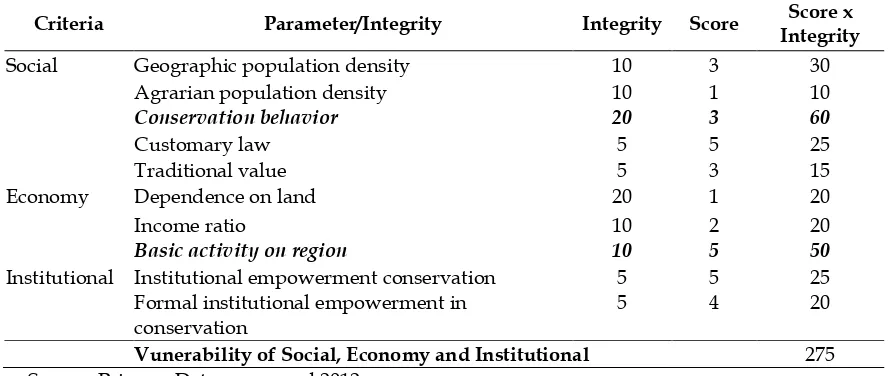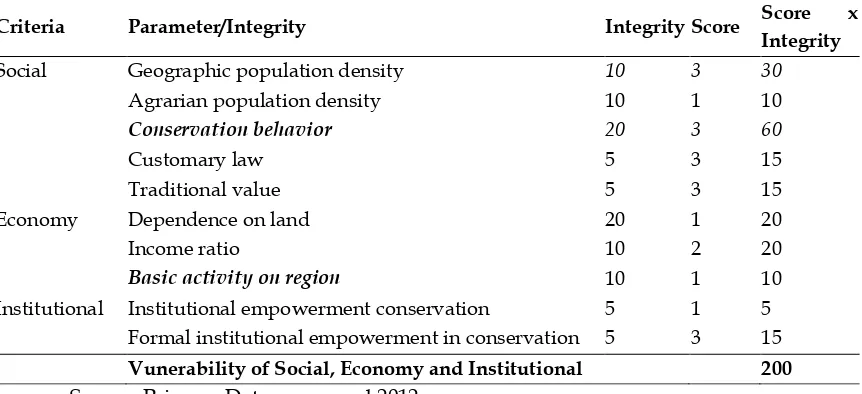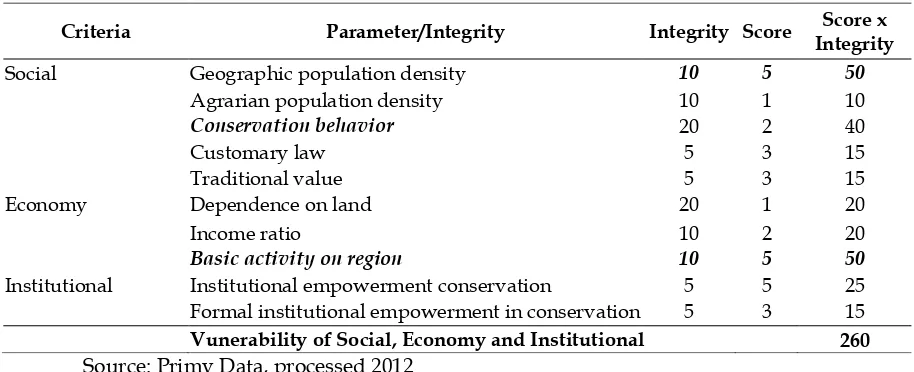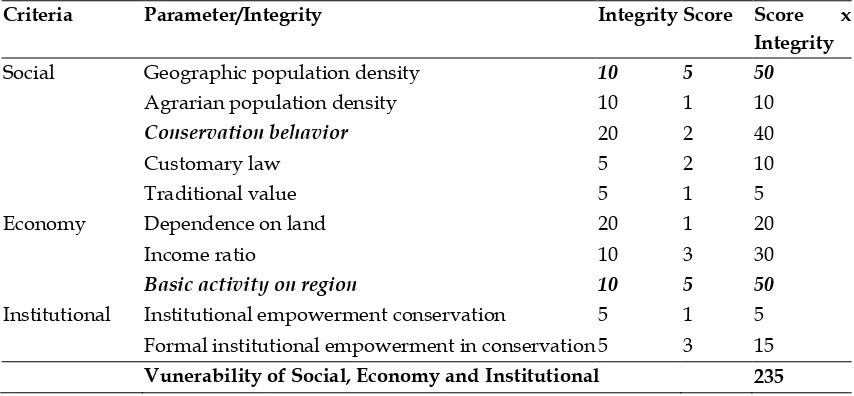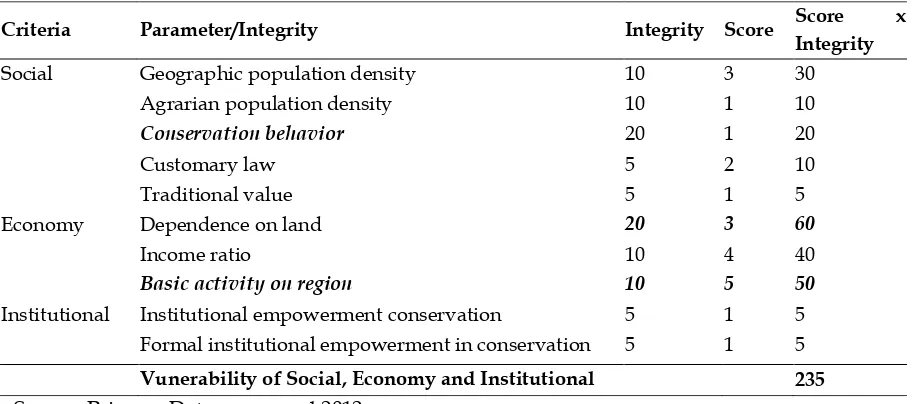Jurnal Ekonomi dan Studi Pembangunan Volume 18, No 1, April 2017, hlm.16-24
SOCIAL-ECONOMICS ANALYSIS AND COMMUNITY
EMPOWERMENT THE WATERSHED OF KEDAUNG AT GAJAH
MUNGKUR RESERVOIR WONOGIRI-CENTAL JAVA
Sarjiyanto1, Supriyadi2,Arif Budi Nugroho3
1 Faculty of Economy and Business, Universitas Sebelas Maret, 57126, Surakarta, Indonesia 2 Faculty of Faculty of Agricultur, Universitas Sebelas Maret, 57126, Surakarta, Indonesia
3 Research and development office of wonogiri district,
E-mail: 1 masyanto@staff.uns.ac.id, 2 supriyadi_uns@yahoo.com, 3 abun2025@gmail.com Correspondence E-mail: masyanto@staff.uns.ac.id
Naskah Diterima: November 2016, Disetujui Februari 2017
Abstract : Gajah Mungkur Reservoir is designed to storage reservoir for 100 years since the operation in 1982-2082. Currently the sedimentation rate reaches 8 millimeters per year, while the assumption of sediment rate (mud) is only 2 millimeters per year. This research was conducted to save reservoir and river basin environment in Gajah Mungkur Reservoir. This study aims to determine the socio-economic conditions and behavior of people in the Keduang River watershed area. This research also formulates community empowerment model in Keduang River area and recommends grand design management system involving various related parties.
Keyword: Community Empowerment, Watershed Areas.
JEL Code: F64, O20
Abstraksi : Waduk Gajah Mungkur dirancang untuk menyimpan cadangan air selama 100 tahun sejak beroperasi pada tahun 1982-2082. Saat ini tingkat sedimentasi mencapai 8 milimeter per tahun, sedangkan asumsi laju sedimen (lumpur) hanya 2 milimeter per tahun. Penelitian ini dilakukan untuk menyelamatkan reservoir dan lingkungan Daerah Aliran Sungai di Waduk Gajah Mungkur. Penelitian ini bertujuan untuk mengetahui kondisi sosial ekonomi dan perilaku orang-orang di daerah DAS Keduang River. Penelitian ini juga merumuskan model pemberdayaan masyarakat di wilayah DAS Keduang River serta merekomendasikan grand design sistem manajemen yang melibatkan berbagai pihak yang terkait.
Kata kunci: Pemberdayaan Masyarakat, Daerah Aliran Sungai (DAS).
Social-Economics Analysis and Community… (Sarjiyanto, Supriyadi, Arif Budi Nugroho) 17
INTRODUCTION
The construction of reservoir in one region is one of the solution of problem exist in that 400m3/s. This would secure all regions around Bengawan Solo stream, starts from Wonogiri, Ngawi, till to downstream in Gresik, East Java, and from flood is also functioned as irrigation, water supplier, and also electricity. The impact from the construction is the change of socio-economy of the people around the reservoir.
Economic success will cause change automatically in the economy structure of the people. In social perspective, the construction will cause the change of social structure where most of people will depend on their livelihood on fishery and tourism. Besides that impact, the positive impacts from the construction of the reservoir are absorption of labor and the increasing of people’s income while the negative impact is pollution to environment, for example sedimentation is occurred faster than the previous estimation.
High sedimentation, especially sedimentation from 6 sub-region river stream which caused limited water storage capability. Gajah Mungkur reservoir is designed for 100 years, counted since the first operation in 1982 until 2082, with the maximum capability of that comes to Gajah Mungkur reservoir reaches 2.55 million m3 each year.
The negative and positive impact surely affects social and economy of the people so that needs the exact society empowerment model. Society empowerment is understood as the promotes human resources participation, organization, and community to increase social life quality.
Society development has so many various definitions. It focused to the study of problem solving process simultaneously. The other definition of society development is to start social action so that it could change their economy, social, culture and environment situation (Mattessich, 2004). Empowerment theory contains two value orientations to practice and frame the concept to learn the society process and organization. Society empowerment is differing into psychology empowerment, organization empowerment, and society empowerment. Problem difference would affect the exact empowerment model in one region so that in this research could be known about the exact empowerment model in Sub watershed Keduang as the impact of Gajah Mungkur reservoir construction.
RESEARCH METHOD
This study uses RRA (Rapid Rural Appraisal) and PRA (Participatory Rural Appraisal) method with consideration of efficiency, effectiveness and more importantly is aspirational in the sense of community involvement and community needs can be accommodated so that the expected model of empowerment in line with the needs of society).
Data collection is done on the documentation of studies that have been made by various parties, in-depth interviews with village officials, community leaders, farmers' groups, conservation groups, youth and aware group travel and also conducted field observations to compare data that obtained from interviews, documentation and questioner. Classification levels of vulnerability was presented on table in below :
Table 1. Classification levels of Social Economy and Institutional Vulnerability
Source: Paimin et al 2006
RESULT AND DISCUSSION
a. Pondoksari Village
Pondoksari Village, District of Nguntoronardi as sample areas that represent sub in downstream watershed of Keduang river. Pondoksari village is located in the
northwestern town of Nguntoronadi district approximately 7 km. Its area is 573 hectares, divided into 9 hamlets, 7 (CA) Citizens Association and 17 (NA) Neighborhood Association with an average altitude of 158 from the surface of the sea. The population in 2009 reached 2287 people with 1151 males and 1136 females.
Table 2. Analysis of Social Economy Institutional sub DownstreamWatershed of Pondoksari
Source: Primary Data, processed 2012
Criteria Score Level Vulnerability High > 4,3 Very Range
Rather High 3,5 – 4,3 Range Moderate 2,6 – 3,4 Rather Range Rather Low 1,7 – 2,5 Slighty Range
Low <1,7 Not Range
Criteria Parameter/Integrity Integrity Score Score x
Integrity
Social Geographic population density 10 3 30
Agrarian population density 10 1 10
Conservation behavior 20 3 60
Customary law 5 5 25
Traditional value 5 3 15
Economy Dependence on land 20 1 20
Income ratio 10 2 20
Basic activity on region 10 5 50
Institutional Institutional empowerment conservation 5 5 25
Formal institutional empowerment in
conservation
5 4 20
Social-Economics Analysis and Community… (Sarjiyanto, Supriyadi, Arif Budi Nugroho) 19 Based on the results of the study was
obtained that geographic population density has a score 3, while scores in the agrarian population density 1, whereas for conservation behaviors have a score 3. Customary law still have important role in the Pondoksari with a score 5, while traditional values have a score 3. Economically, state of residents base on dependence on land had a score 1 and an income ratio had a score 2. Based on the presence of institutional conservation and formal institutions empowerment on conservation scores respectively 5 and 4.
b. Sembukan Village
Sembukan village, district of Sidoharjo was selected to represent sub middle watershed as research sample. Sembukan village approximately 8 km away from town of Sidoharjo district and the village that southernmost in Sidoharjo district. Its area is
1272 ha, which is divided into 11 hamlets, 9 (CA) Citizens Association and 21 (NA) Neighborhood Association. The average elevation of this village approximately 355 from the surface of the sea. From the census of 2009 total population of 4239 people with 2194 males and 2045 womens.
Based on the results of the study was obtained that geographic population density has a score 3, while scores in the agrarian population density 1, whereas for conservation behaviors have a score 3. Customary law still have important role in the Sembukan with a score 3, while traditional values have a score 3. Economically, state of residents base on dependence on land had a score 1 and an income ratio had a score 2. Based on the tpresence of institutional conservation and formal institutions empowerment on conservation scores respectively 1 and 3.
Table 3. Analysis of Social Economy Institutional sub Middle Watershed of Sembukan
Source: Primary Data, processed 2012
c. Padarangin village
Padarangin village, district of Slogohimo was selected to represent sub upstream watershed as research sample. Padarangin village approximately 7.8 km away from town of Slogohimo district. Its area is 799 ha, which is
divided into 5 hamlets, 7 (CA) Citizens Association and 21 (NA) Neighborhood Association. The average elevation of this village up 628 from the surface of the sea. From the census of 2009 total population of 3426 people with 1687 males and 1739 womens.
Criteria Parameter/Integrity Integrity Score Score x
Integrity
Social Geographic population density 10 3 30
Agrarian population density 10 1 10
Conservation behavior 20 3 60
Customary law 5 3 15
Traditional value 5 3 15
Economy Dependence on land 20 1 20
Income ratio 10 2 20
Basic activity on region 10 1 10
Institutional Institutional empowerment conservation 5 1 5
Formal institutional empowerment in conservation 5 3 15
Table: 4 Analysis of Social Economy Institutional sub Upstream Watershed of Pandarangin
Source: Primary Data, processed 2012
Based on the results of the study was obtained that geographic population density has a score 5, while scores in the agrarian population density 5, whereas for conservation behaviors have a score 1. Customary law still have important role in the Padarangin with a score 3, while traditional values have a score 1. Economically, state of residents base on dependence on land had a score 1 and an income ratio had a score 4. Based on the presence of institutional conservation and formal institutions empowerment on conservation scores respectively 5 and 3.
d. Semin Village
Semin village, district of Nguntoronadi was selected to represent micro sub watershed at south as research sample. Semin village is located at east from town of Nguntoronadi district with distance approximately 7,8 km. Its area is 726 ha, which is divided into 7 hamlets, 7 (CA) Citizens Association and 16 (NA) Neighborhood Association. The average elevation of this village up 628 from the surface of the sea. From the census of 2009 total population of 3121 people with 1552 males and 1569 womens.
Table 5. Analysis of Social Economy Institutional Micro sub Watershed at South Side (Semin Village)
Source: Primy Data, processed 2012
Criteria Parameter/Integrity Integrity Score Score x
Integrity
Social Geographic population density 10 5 50
Agrarian population density 10 5 50
Conservation behavior 20 1 20
Customary law 5 3 15
Traditional value 5 1 5
Economy Dependence on land 20 1 20
Income ratio 10 4 40
Basic activity on region 10 5 50
Institutional Institutional empowerment conservation 5 5 25
Formal institutional empowerment in conservation 5 3 15
Vunerability of Social, Economy and Institutional 290
Criteria Parameter/Integrity Integrity Score Score x
Integrity
Social Geographic population density 10 5 50
Agrarian population density 10 1 10
Conservation behavior 20 2 40
Customary law 5 3 15
Traditional value 5 3 15
Economy Dependence on land 20 1 20
Income ratio 10 2 20
Basic activity on region 10 5 50
Institutional Institutional empowerment conservation 5 5 25
Formal institutional empowerment in conservation 5 3 15
Social-Economics Analysis and Community… (Sarjiyanto, Supriyadi, Arif Budi Nugroho) 21 Based on the results of the study was
obtained that geographic population density has a score 5, while scores in the agrarian population density 1, whereas for conservation behaviors have a score 2. Customary law still have important role in the Semin with a score 3, while traditional values have a score 3. Economically, state of residents from dependence on land had a score 1 and an income ratio had a score 2. Based on the presence of institutional conservation and formal institutions empowerment on conservation scores respectively 5 and 3.
e. Semagar Village
Semagar village, district of Girimarto as selected to represent micro sub watershed at west of north region as research sample. Semagar village is located at east from town of Girimarto district with distance approximately 5 km away. Its area is 498.77 ha, which is divided into 8 hamlets, 8 (CA) Citizens Association and 19 (NA) Neighborhood Association. The average elevation of this village approximately 600 m from the surface of the sea. From the census of 2009 total population of 3591 people with 1818 males and 1773 womens.
Table 6. Analysis of Social Economy Institutional Micro sub Watershed at West On North Region (Semagar village)
Criteria Parameter/Integrity Integrity Score Score x
Integrity
Institutional Institutional empowerment conservation 5 1 5
Formal institutional empowerment in conservation 5 3 15
Vunerability of Social, Economy and Institutional 235
Source: Primary Data, processed 2012
Based on the results of the study was obtained that geographic population density has a score 5, while scores in the agrarian population density 1, whereas for conservation behaviors have a score 2. Customary law still have important role in the Semagar with a score 2, while traditional values have a score 1. Economically, state of residents base on dependence on land had a score 1 and an income ratio had a score 3. Based on the presence of institutional conservation and formal institutions empowerment on conservation scores respectively 1 and 3.
f. Setren village
Table 7. Analysis of Social Economy Institutional Micro Sub Watershed at East On North Region (Setren Village)
Source: Primary Data, processed 2012
Based on the results of the study was obtained that geographic population density has a score 3, while scores in the agrarian population density 1, whereas for conservation behaviors have a score 1. Customary law still have important role in the Setren with a score 2, while traditional values have a score 1. Economically, state of residents base on dependence on land had a score 3 and an income ratio had score 4. Based on the presence of institutional conservation and formal institutions empowerment on conservation scores 1.
Empowerment Model
Empowerment model at each sub watershed was based on scoring of social, economy and institutional analysis. Empowerment refered to decrease vulnerability on parameter from each criteria that have highest vulnerability value, then it connected with comunity needs that was resulted from interview and observation at field. Hopefully, that model can be done and accepted by comunity. Because empowerment principle is an effort to achieve community needs, so “stranger” doesn’t have a role as a instructor or builder but have the role as facilitators that be in charge to facilitate, push and ease community in order to empowerment themself. So that facilitators only facilitate in terms of problem analysis, organization assist and advocation of rules.
Table 8. Models of Empowerment in Watershed Kedaung that Priorited on Resident Management and Basic Activity on Region
CRITERIA ACTIVITY FACILITATORS
Social Economy Improvement of tourism village/village charm Depart. of Tourism
Training of farmer on agrotourism Depart. of Agriculture
Management of daity cattle/ etawa goat Depart. of Agriculture
Management of livestock and animal waste
(biogas, manure) Environmental agency
Empowerment of integrated farming system Depart. of Agriculture
Criteria Parameter/Integrity Integrity Score Score x
Integrity
Social Geographic population density 10 3 30
Agrarian population density 10 1 10
Conservation behavior 20 1 20
Customary law 5 2 10
Traditional value 5 1 5
Economy Dependence on land 20 3 60
Income ratio 10 4 40
Basic activity on region 10 5 50
Institutional Institutional empowerment conservation 5 1 5
Formal institutional empowerment in conservation 5 1 5
Social-Economics Analysis and Community… (Sarjiyanto, Supriyadi, Arif Budi Nugroho) 23
CRITERIA ACTIVITY FACILITATORS
Management agricultural product/livestock to support tourism village (typical souvenirs from Setren)
Empowerment Board villagers
Training of local tradition Depart. of Tourism
Training of souvenirs making (puppet, tradition
local) Department of Trade
Improvement of tourism market Depart. of cooperative
Training of conservation technic (land
management, breeding) Estate agency
Cultivation on community
forest/garden/horticultura with basic of
improvement tourism (durian, coffee beans, avocado,cacao,snakefruit, vegetables)
Depart. of Agriculture
Cultivation of fishing pond Fisheries department
Regulation Institutional
Empowerment of farmer group/ training of
tourism farmer Empowerment Board
Empowermnet of Farmers Community Local Goverment
Reinforcement of cooperation in community
(managemnet training) Depart. of cooperative
Organizing of conservation village device Farmers Community
Source: Mapping results, 2012
CONCLUSION AND
RECOMMENDATIONS
A. Conclusion
The result from analysis of vulnerability levels on social, economy and institutional was obtained score to each sample region, as follows :
a) Pondoksari village score 275 in the category moderate with vulnerability level is slightly susceptible, the highest vulnerability value on activity of conservation and region basic activity.
b) Sembukan village score 200 in the category slightly low with vulnerability level is slightly susceptible, the highest vulnerability value on activity of conservation and geographic population density.
c) Padarangin village score 290 in the category moderate with vulnerability level is slightly susceptible, the highest vulnerability value on geographic population density, agrarian population denstiy and region basic activity.
d) Semin village score 260 in the category moderate with vulnerability level is slightly susceptible, the highest vulnerability value on geographic population density and region basic activity.
e) Semagar village score 235 in the category slightly low with vulnerability level is slightly susceptible, the highest vulnerability value on geographic population density and region basic activity.
f) Setren village score 235 in the category slightly low with vulnerability level is slightly susceptible, the highest vulnerability value on land dependence and region basic activity.
B. Recommendation
a. Watershed management implementation must always associate with accessibility conditions that exist in society. The more open society conditions will be different with a more closed society.
b. Improvement income can be done with earn income outside agriculture, especially livestock, trading, agroindustry and activity that basic on resources on watershed region.
c. Model of participate natural resources conservation can be done according to the stage where an understanding of conservation socialized well, especially in the coordination group given the authority to coordinate the relevant stakeholders that support conservation activities. In addition, needed the individual commitment of the decision makers on-site conservation activities. Therefore, coordination and socialization understanding of the importance of conservation with related agencies should be conducted continuously through a variety of formal and informal meetings without any limitation of quantity meeting. d. Need to be arranged grand design Keduang watershed management that it is linking various stakeholders. Grand design that really targeted and sustainable is in effort to collaborate the work program which is owned by each work area unit of Wonogiri local government so that Keduang community development and conservation and watershed management will not overlap in TUPOKSI and programs.
REFERENCES
Bappeda dan BPS Kabupaten Wonogiri, 2010 “Wonogiri Dalam Angka Tanun 2010”. Bappeda dan BPS Kabupaten Wonogiri, 2010,
“Kecamatan Girimarto Dalam Angka Tahun 2009”.
Bappeda dan BPS Kabupaten Wonogiri, 2010, “Kecamatan Nguntoronadi Dalam Angka Tahun 2009”.
Bappeda dan BPS Kabupaten Wonogiri, 2010, “Kecamatan Sidoharjo Dalam Angka Tahun 2009”.
Bappeda dan BPS Kabupaten Wonogiri, 2010, “Kecamatan Slogohimo Dalam Angka Tahun 2009”.
Bappeda dan BPS Kabupaten Wonogiri, 2010, “PDRB Kabupaten Wonogiri Tahun 2009”.
Bappeda Kabupaten Wonogiri, 2010, “Data dan Analisis Rencana Tata Ruang Wilayah (RTRW) Kabupaten Wonogiri Tahun 2010-2030”.
Bappeda Kabupaten Wonogiri, 2010, “Laporan Kegiatan Penunjang Penyusunan dan Pengembangan Profil Daerah Kabupaten Wonogiri Tahun 2009”.
Dewi R Indrawati, Purwanto, dan Paimin, 2009
“Formulasi Kerentanan Sosial Ekonomi
dan Kelembagan sebagai Diagnosis Degradasi Lahan”.
Laverack, G.; Wallerstein, N. 2001. Measuring community empowerment: a fresh look at organizational domains. Health Promot. Int.
Mattessich, P. and Monsey, M. 2004. Community Building: What Makes It Work, St. Paul.
MN: Wilder Foundation.
